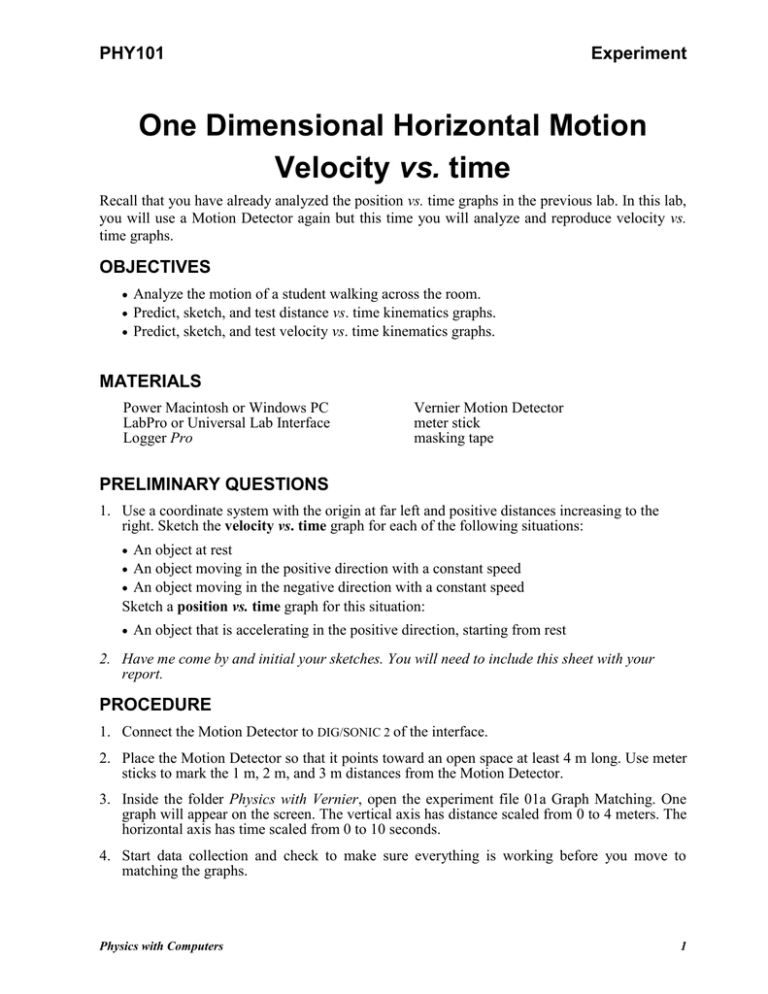Newton*s Second Law of Motion
advertisement

PHY101 Experiment One Dimensional Horizontal Motion Velocity vs. time Recall that you have already analyzed the position vs. time graphs in the previous lab. In this lab, you will use a Motion Detector again but this time you will analyze and reproduce velocity vs. time graphs. OBJECTIVES Analyze the motion of a student walking across the room. Predict, sketch, and test distance vs. time kinematics graphs. Predict, sketch, and test velocity vs. time kinematics graphs. MATERIALS Power Macintosh or Windows PC LabPro or Universal Lab Interface Logger Pro Vernier Motion Detector meter stick masking tape PRELIMINARY QUESTIONS 1. Use a coordinate system with the origin at far left and positive distances increasing to the right. Sketch the velocity vs. time graph for each of the following situations: An object at rest An object moving in the positive direction with a constant speed An object moving in the negative direction with a constant speed Sketch a position vs. time graph for this situation: An object that is accelerating in the positive direction, starting from rest 2. Have me come by and initial your sketches. You will need to include this sheet with your report. PROCEDURE 1. Connect the Motion Detector to DIG/SONIC 2 of the interface. 2. Place the Motion Detector so that it points toward an open space at least 4 m long. Use meter sticks to mark the 1 m, 2 m, and 3 m distances from the Motion Detector. 3. Inside the folder Physics with Vernier, open the experiment file 01a Graph Matching. One graph will appear on the screen. The vertical axis has distance scaled from 0 to 4 meters. The horizontal axis has time scaled from 0 to 10 seconds. 4. Start data collection and check to make sure everything is working before you move to matching the graphs. Physics with Computers 1 Experiment 2 5. Open the experiment file 01d Graph Matching. You will see the following velocity vs. time graph. 6. Before your start, think about how you would walk to produce this target graph. Analyze each type of motion separately, for example, for the previous graph you have the following intervals to analyze: [0 to 2 s], [2 s to 5 s], [5 s to 7 s], [7 s to 10 s]. All these intervals of time represent different types of motion. For each of these intervals, you must know the distance covered, what were the velocities, and what was the ACCELERATION in that interval of time 7. To test your prediction, choose a starting position and stand at that point. Start Logger Pro by clicking . When you hear the Motion Detector begin to click, walk in such a way that the graph of your motion matches the target graph on the screen. It will be more difficult to match the velocity graph than it was for the distance graph. 8. Save your best attempt on your floppy disk, or a memory stick. You will need to include a printout with your report. A good strategy is to save each reasonable attempt; you can always delete the bad files later. 9. Open the experiment file 01e Graph Matching. Repeat Steps 6 – 8 to match this graph. 2 Physics with Computers Graph Matching 10. Answer the following questions. These questions need to be answered in your lab report. (a) Describe how you walked to match each graph by filling in the following table: Interval Initial time t1 (s) Final time t2 (s) Δt (s) Initial velocity v1 (m/s) Final velocity v2 (m/s) Δv (m/s) Acceleration a (m/s2) Displacement Δx (m) You will need to be very organized and specific with regards to time intervals, displacements, velocities, directions and ACCELERATIONS! Divide the plots in time intervals first. Each time interval should refer to a type of motion, until that motion was changed. Therefore, time intervals are not necessarily equal to 1 s or 2 s, etc, it depends on how long a certain type of motion lasted. (b) Using the velocity vs. time graphs, sketch the corresponding distance vs. time graph for each of the graphs that you matched. (c) What does the area under the velocity vs. time graph represent? (d) What type of motion is occurring when the slope of a velocity vs. time graph is zero? (e) What type of motion is occurring when the slope of a velocity vs. time graph is +5 m/s2? REPORT As with your first lab report, for this experiment your report should include only the following: 1) Cover sheet with title of the experiment, number of the experiment, date, your name, instructor’s name, course number, section number. 2) Preliminary sketches initialed by me. 3) Printouts of your best attempts at matching the graphs 01d and 01e. LABEL your printouts, i.e., give them a title. Every time you refer to your two printouts, refer to their title. Every graph or printout should always have a title or label. 4) Answers to questions in step 10. Questions 10a and 10b need to be answered for graphs 01d and 01e. 5) Present the following exercise in your report (you can present these sketches in one page of paper, it doesn’t even need to be graph paper, but you need to clearly define the time intervals in all your sketches): Sketch the velocity vs. time graph for an object that: • from 0 to 2 seconds has moved with constant velocity of 3 m/s • from 2 to 5 seconds was at rest • from 5 to 10 seconds increased its velocity, reaching 5 m/s at t =10 s. Now make the following separate plots for the same object: • Acceleration vs. time • Position vs. time, assuming the initial position at x0 = 0. Physics with Computers 3




